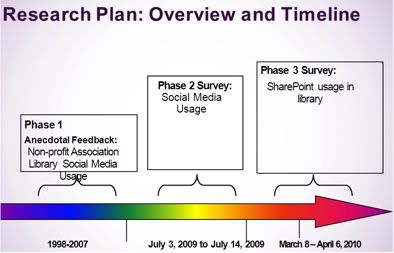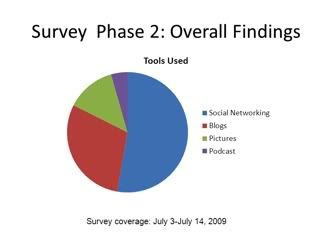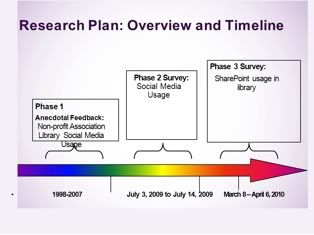Introduction
There are so many consultants that exist who say their applications will make SharePoint “user-friendly”. Through my study last year, I found out that librarians were using SharePoint in the corporate, government, and non-profit sectors (Weldon, 2010). In the latest volume of my study, SharePoint Without Coding, Volume 2: My Notes on the Further Embedment of the Librarian, I give a step by step process of how to find out what other librarians are doing with SharePoint “out-of-the-box” and how to incorporate their experiences with social media site tools to help meet their library management needs within the SharePoint 2003 and 2007 platform (Weldon, 2011).
User-friendly
Consultants and vendors have great applications to add to SharePoint to make a librarian’s life easier. The problem with these applications is that they cost money. The applications are not easy to obtain if the library budget does not allow for purchases of these “add-on” applications. Through further analysis of librarians’ viewpoints about SharePoint, it has been found that “out-of-the-box” SharePoint was geared for staff with a project management and computer programming background (2011).
Microsoft embedded social media tools within the SharePoint platform. World-wide librarians have been customizing SharePoint by using their social networking skills from MySpace, Facebook, LinkedIn, etc. It is a “plug and play” social media tool for the office. It has helped to embed the researching skills of the librarians within the normal business flow of their sectors (2011).
IT Department Still Required
The majority of the government, corporate, and non-profit sectors reviewed had their library sites housed on internal servers (2011). Through IT staff, the backbone of the SharePoint platform is upgraded and maintained for the different sectors. Hosted servers allowed librarians the flexibility to have a one-on-one relationship with their “own” IT department.
The on-site IT departments, within these sectors, were found to have high-turnover of staff, over-worked staff, or a little of both (2011). The librarians found dependence on the IT department for their customization needs. Librarians would have to wait on a schedule of priorities that the IT staff would be following. Through further discussion in SharePoint Without Coding, Volume 2: My Notes on the Further Embedment of the Librarian, librarians were found to need only site administrator’s permission in order to customize and manage their SharePoint-based sites (2011).
The secret is to understanding the site templates that Microsoft has given librarians through SharePoint “out-of-the-box”. These templates are based on social networking abilities and not program coding. It is through a “plug and play” effort that librarians can find the features in SharePoint that they would need to help them manage their library collections. The following is a feature-map of social media tools matched to SharePoint features to meet librarians’ needs (2011).

A Three-Phased Approach
Through a 3-phased approach, 530 member sample of 35,000 members of a non-profit association library helped to define how well the library (and librarian) was already embedded within the association (2007).

Phase 1 was the qualitative review of anecdotal feedback from members and staff between the years of 1998 to 2007. Phase 2 was a survey asking librarians about the different types of social media tools they have used for their research. Through the second phase, it was found that the majority of the survey participants used social media tools, other than the usual social media tools (blogs, pictures, and podcasts). Social media tools were the MySpace, LinkedIn and Facebook sites. This can be seen in the following figure.

Phase 3 was a survey asking librarians how they used SharePoint. The following diagram shows the time each phase had taken.

This is described in more detail in SharePoint Without Coding, Volume 2: My Notes on the Further Embedment of the Librarian (2011). Phase 1’s anecdotal feedback came from subject discussions and requests from members. Feedback was also reviewed from phone call requests captured in the request database. Phase 2 was to find out what Web 2.0 tools were being used by business related professionals. There were 441 respondents who were under the following subject concentrations: Library Science; Business; Education; Other. In Phase 3, librarians world-wide were surveyed to find out how they have used SharePoint. Phase 3 allowed a breakdown of what social media tools librarians would use in SharePoint. The document library tool was used by all sectors (government, education, associations, and private). E-alerts seemed to be used only by associations and the pictures library tool was used only by the government sector. Government librarians were found to use SharePoint the most.
Conclusion
SharePoint can be customized through social networking skills without the help of “add-on” applications. In order to gain this “power” to customize their sites, librarians need to develop a working relationship with their organization’s IT department. The IT staff can grant them access to their own section on the organization’s SharePoint-based intranet. Once the librarian has access to their “own” SharePoint-based site, they will be able to use “out-of-the-box” features to “plug and play” what components they would want to help with their library management. This approach takes minimal training and would create a happier environment for librarians.
References
- DuFour, R. (2004). What is a “Professional Learning Community”? Retrieved on July 4, 2009 from http://schools.fsusd.k12.ca.us/education/PLC/Prof_Lrng_Community.pdf
- Weldon, L. (2011, February). SharePoint without Coding, Volume 2: My Notes on the Further Embedment of the Librarian. http://www.amazon.com/SharePoint-Without-Coding-Embedment-Librarian/dp/1453700994/ref=ntt_at_ep_dpt_2
- Weldon, L. (2010). SharePoint without Coding: My Notes for Embedding the Librarian. http://www.amazon.com/SharePoint-without-Coding-Embedding-Librarian/dp/1452821984/ref=ntt_at_ep_dpt_1
- Weldon, Lorette S.J. “Basic Search Set-up in “Out of the Box” SharePoint” LLRX.com. February 2011
- Weldon, Lorette S.J. “The Online Oral Academic Learning Community” LLRX.com. September 2010
- Weldon, Lorette S.J., et al. “Documentation Capturing” LLRX.com. August 2010.
- Weldon, Lorette S.J. “How is SharePoint used in Libraries?” FUMSI, a FreePint Family Publication, at http://web.fumsi.com/go/article/use/4714 in August 2010.
- Weldon, Lorette S.J. “Development of a SharePoint Site?“, LLRX.com. July 2010.
- Weldon, Lorette S.J. “Problems with Creating a Course to Help Colleagues?” LLRX.com. June 2010.
- Weldon, Lorette S.J. “Are You SharePoint-Ready?“, LLRX.com. May 2010.
- Weldon, Lorette S.J. “The Odd Couple: SharePoint and Librarians“, LLRX.com. April 2010.
- Weldon, Lorette S.J. “Taking Your Library on the Road”, Computers in Libraries. May 2009:12-16.
- Weldon, Lorette S.J. “Googlization of the Library Collection”, Special Library Association’s Information Outlook, April/May 2009 (Vol.13, No. 3).
- Weldon, Lorette S.J. “My Virtual Assistant Saves the Day”, Computers in Libraries, November/December 2007:18-23.
- Weldon, Lorette S.J. “Getting the Answers: One Consultant’s Approach to Deciphering the Government”, Special Libraries Association’s Information Outlook, September 2005, p.33-34.
